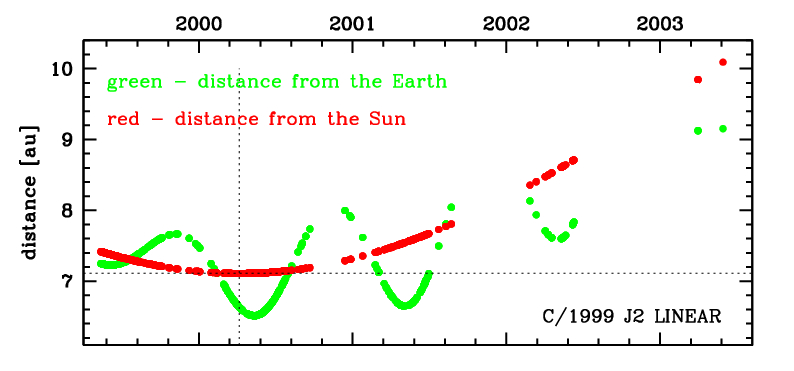C/1999 J2 LINEAR
more info
C/1999 J2 was discovered by B. Skiff of Lowell Observatory Near-Earth Object Search (LONEOS) team on 13 May 1999, 0.92 yr before perihelion passage.
This comet made its closest approach to the Earth on 11 May 2000 (6.515 au), about one month after perihelion.
Solution given here is based on data spanning over 4.1 yr in a range of heliocentric distances: 7.42 au – 7.110 au (perihelion) – 10.1 au.
This Oort spike comet suffers small planetary perturbations during its passage through the planetary system that lead to escape of the comet from the solar system on hiperbolic orbit (see future barycentric orbit).
See also Królikowska 2014 and Królikowska and Dybczyński 2017.
This comet made its closest approach to the Earth on 11 May 2000 (6.515 au), about one month after perihelion.
Solution given here is based on data spanning over 4.1 yr in a range of heliocentric distances: 7.42 au – 7.110 au (perihelion) – 10.1 au.
This Oort spike comet suffers small planetary perturbations during its passage through the planetary system that lead to escape of the comet from the solar system on hiperbolic orbit (see future barycentric orbit).
See also Królikowska 2014 and Królikowska and Dybczyński 2017.
| solution description | ||
|---|---|---|
| number of observations | 1001 | |
| data interval | 1999 05 12 – 2003 05 29 | |
| data type | perihelion within the observation arc (FULL) | |
| data arc selection | entire data set (STD) | |
| range of heliocentric distances | 7.42 au – 7.11 au (perihelion) – 10.1 au | |
| detectability of NG effects in the comet's motion | NG effects not determinable | |
| type of model of motion | GR - gravitational orbit | |
| data weighting | YES | |
| number of residuals | 1974 | |
| RMS [arcseconds] | 0.53 | |
| orbit quality class | 1a+ | |
| orbital elements (heliocentric ecliptic J2000) | ||
|---|---|---|
| Epoch | 2000 04 06 | |
| perihelion date | 2000 04 06.00425500 | ± 0.00091200 |
| perihelion distance [au] | 7.10975456 | ± 0.00000468 |
| eccentricity | 1.00103030 | ± 0.00000456 |
| argument of perihelion [°] | 127.140062 | ± 0.000063 |
| ascending node [°] | 50.042583 | ± 0.000012 |
| inclination [°] | 86.412706 | ± 0.000009 |
| reciprocal semi-major axis [10-6 au-1] | -144.91 | ± 0.64 |
